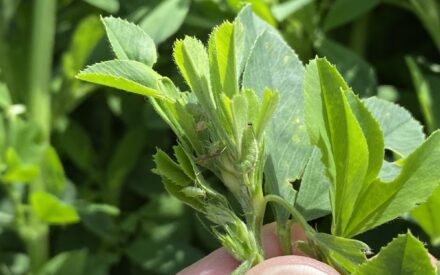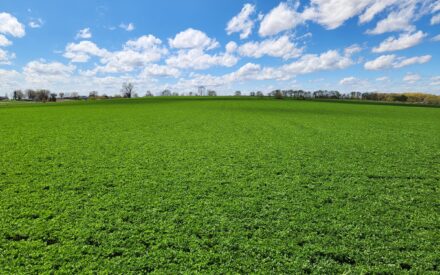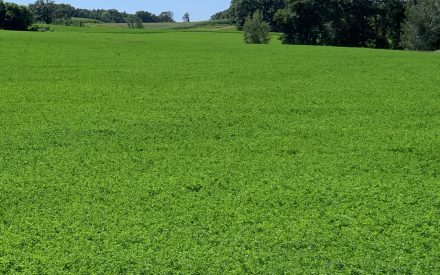Weed suppression can be important during alfalfa establishment as weeds can reduce stand life, alfalfa biomass, and forage quality. To reduce these impacts producers commonly apply herbicides to establishing alfalfa. A range of options exist, but the most common applications include imazamox (Raptor) or imazethapyr (Pursuit). These compounds have traditionally given the best control of common weeds (e.g., lambsquarter & foxtail species) and can be applied post emergent. With the introduction of Roundup Ready® alfalfa, producers now have an additional choice for weed management.
Weed management with glyphosate has benefits compared to imazamox and imazethapyr. Imazamox and imazethapyr can cause injury to seedling alfalfa resulting in biomass reductions up to 20% in the 1st cutting of the establishment year. In contrast, no injury or yield reduction has been observed with glyphosate in Roundup Ready® alfalfa. Additionally, to avoid reduced efficacy, it is recommended that imazamox and imazethapyr be applied to small weeds that are less than or equal to 3 inches tall or in diameter. It can be difficult for producers to make applications to weeds at this stage as imazamox and imazethapyr cannot be applied until the alfalfa seedlings have at least two trifoliate leaves. Alfalfa plants often do not reach this stage until weeds are larger than 3 inches. Due to this, applications are typically made 2 to 3 weeks after the weeds were at the 3 inch stage, resulting in reduced control. This lower level of control can also result in reductions in alfalfa biomass and decreased forage quality. Glyphosate use in Roundup Ready® alfalfa is not restricted with respect to the stage of alfalfa and glyphosate’s effectiveness has been demonstrated on larger weeds. Thus, the Roundup Ready® alfalfa establishment system offers many benefits to producers. However, these benefits are expensive as every bag of Roundup Ready® alfalfa seed has an additional fee of $125. Information is needed to help producers make an informed decision on when the benefits of Roundup Ready® alfalfa outweigh the additional costs in direct seeded establishment methods. I will present research results that will compare establishment systems at a field scale at seven sites across Wisconsin.
Methods
We established seven fields with Roundup Ready® alfalfa. One field was established in each of the following Wisconsin counties: Brown, Clark, Dane, Door, Fond du Lac, Jackson, and Washburn. At each site we used a randomized complete block design with three replications. Each plot was 10-20’ wide and 50-125’ long depending on the site. Treatments consisted of glyphosate + AMS applied at 0.75 lbs ae/A or imazamox + MSO applied at 0.04 lbs ae/a (Raptor at 5 fl oz/A). Applications of either glyphosate or imazamox were made to weeds 1 to 3” in height/diameter or 4 to 8” height/diameter (2 to 3 weeks after 1st treatment) in addition to an untreated control (5 treatments per site). Visual estimates of control of major weed species and percent injury and growth reduction of alfalfa were taken prior to each harvest. Plots were harvested by randomly placing three 0.5 m2 quadrats in each plot. Samples were separated into weeds and alfalfa, dried, and weighed. Due to drought, only four sites were harvested for the 2nd cut (Clark, Dane, Fond du Lac, and Jackson counties).
Results
Weed control and alfalfa injury: Weed pressure varied between sites with low weed pressure at Dane (<15% weed biomass in 1st cut of untreated control); moderate weed pressure at Brown, Fond du Lac, and Jackson (40-50% weed biomass in 1st cut of untreated control); and high weed pressure at Clark, Door, and Washburn (> 60% weed biomass in 1st cut of untreated control). Lambsquarter control, summarized across locations, was best (94%) when glyphosate applications were made to small plants compared to all other treatments. When sites were analyzed separately, Imazamox applied to small weeds gave similar control as glyphosate applied at the same timing at three sites, but across locations did not control lambsquarter as well (75%). This suggests that environmental and physical factors affect control with imazamox more than glyphosate. While variable among sites, visual injury and growth reduction was greater with imazamox treatments at the later timing (13 and 5%, respectively) when analyzed across sites.
Forage yield: Total forage yield was greatest in the untreated areas in the 1st cut, but consisted of 54% weeds when analyzed across sites. Glyphosate applied early provided the highest percentage of alfalfa (96%) compared to other herbicide treatments (71-79%). However, when locations are analyzed separately no benefit in percent of alfalfa was found in the low weed pressure site (Dane), percentage of alfalfa was similar between all herbicide treatments but higher than untreated plots at moderate weed pressure sites (Brown, Fond du Lac, Jackson), and glyphosate applied to small weeds performed the best at the high weed pressure locations (Clark, Door, and Washburn). Due to drought conditions, only four locations were cut a 2nd time. In three of the four locations percent alfalfa was similar among herbicide treatments, with two sites having higher alfalfa percentages compared to untreated plots. In Clark county alfalfa percentage was similar across all treatments.
Forage quality: Samples are currently being analyzed for forage quality.
Alfalfa plant density: Alfalfa density was variable within and among sites. Analysis across sites found that glyphosate applied to small weeds resulted in higher alfalfa densities compared to late applications of imazamox or the untreated control. Differences in alfalfa plant density, however, were only observed at one location (Dane), in which early applications of glyphosate and late applications of imazamox resulted in more alfalfa plants compared to other treatments. This location was under severe drought stress in the spring and early summer, which likely contributed in the difference compared to other locations.
Conclusions
Glyphosate provided equivalent or superior control of lambsquarter and other weed species (data not presented) with less crop injury across the seven locations in 2012. Analyzed across sites, resulting forage biomass had the highest percentage alfalfa when glyphosate was applied to small weeds. However, analysis of sites separately indicate the percentage of alfalfa is similar in fields with low weed pressure, greater with any herbicide treatment in fields with moderate weed pressure, and consistently greatest with glyphosate applied to small weeds in fields with high weed pressure. Alfalfa plant density across sites was highest with glyphosate applications to small weeds. However within each site densities were highly variable, but similar among treatments at five out of the six locations. This suggests environmental and physical factors control stand density to a greater degree than weed management methods. While it remains difficult to predict weed pressure of a field for a given year, benefit in the seeding year was only evident in these areas. Determination of the forage quality of samples will be critical in assessing the economic value of these various management methods.

 ▶ Forage Insect Pest Update
▶ Forage Insect Pest Update ▶ Determining the Value of Standing Forage
▶ Determining the Value of Standing Forage First crop insect scouting in alfalfa
First crop insect scouting in alfalfa


